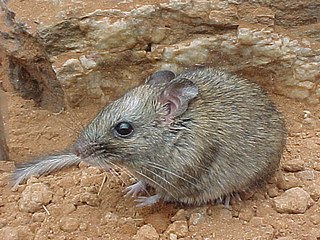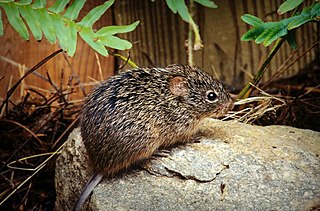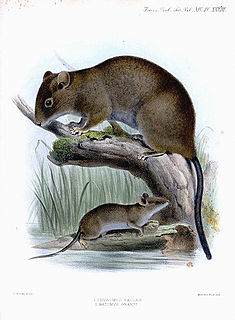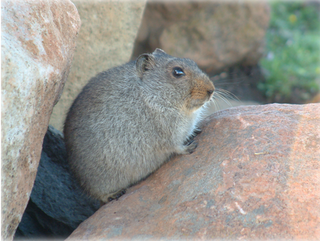
The Muroidea are a large superfamily of rodents, including mice, rats, voles, hamsters, gerbils, and many other relatives. They occupy a vast variety of habitats on every continent except Antarctica. Some authorities have placed all members of this group into a single family, Muridae, due to difficulties in determining how the subfamilies are related to one another. The following taxonomy is based on recent well-supported molecular phylogenies.

Zyzomys is a genus of rodents with unusually thick, long tails. Five species of the genus are known in Australia, where they are called rock rats or thick-tailed rats. The genus was classified by Michael Rogers Oldfield Thomas in 1909.

Papagomys is a genus of very large rats in the tribe Rattini of the subfamily Murinae. It contains two species, which are known only from the Indonesian island of Flores:

Oryzomys nelsoni is an extinct rodent of María Madre Island, Nayarit, Mexico. Within the genus Oryzomys of the family Cricetidae, it may have been most closely related to the mainland species O. albiventer. Since its first description in 1898, most authors have regarded it as a distinct species, but it has also been classified as a mere subspecies of the marsh rice rat (O. palustris).

The subfamily Tylomyinae consists of several species of New World rats and mice including the vesper and climbing rats. They are not as well known as their relatives in the subfamilies Sigmodontinae and Neotominae. Many authorities place all three of these subfamilies in a single subfamily, Sigmodontinae.

A cotton rat is any member of the rodent genus Sigmodon. Cotton rats have small ears and dark coats, and are found in North and South America. Members of this genus are distributed in the Southwestern United States, Mexico, Central America, and South American countries of: Venezuela, Ecuador, Colombia, Peru, Brazil, Guyana, and Suriname. Many of the species are found in Mexico.

Oryzomys is a genus of semiaquatic rodents in the tribe Oryzomyini living in southern North America and far northern South America. It includes eight species, two of which—the marsh rice rat (O. palustris) of the United States and O. couesi of Mexico and Central America—are widespread; the six others have more restricted distributions. The species have had eventful taxonomic histories, and most species were at one time included in the marsh rice rat; additional species may be recognized in the future. The name Oryzomys was established in 1857 by Spencer Fullerton Baird for the marsh rice rat and was soon applied to over a hundred species of American rodents. Subsequently, the genus gradually became more narrowly defined until its current contents were established in 2006, when ten new genera were established for species previously placed in Oryzomys.

Arvicanthis is a genus of rodent from Africa. They are commonly referred to as unstriped grass mice, unstriped grass rats, and kusu rats.

Bandicota is a genus of rodents from Asia known as the bandicoot rats. Their common name and genus name are derived from the Telugu language word pandikokku (పందికొక్కు). DNA studies have found the group to be a monophyletic clade sister to the radiation of Molucca and Australian Rattus species as part of the paraphyletic Rattussensu lato.

Batomys is a genus of rodent endemic to the Philippines. It has six described species.

The white-toothed rats, genus Berylmys, are a group of Old World rats from Asia.

Tokudaia is a genus of murine rodent native to Japan. Known as Ryūkyū spiny rats or spinous country-rats, population groups exist on several non-contiguous islands. Despite differences in name and appearance, they are the closest living relatives of the Eurasian field mouse (Apodemus). Of the three species, both T. osimensis and T. tokunoshimensis have lost their Y chromosome and SRY gene; the sex chromosomes of T. muenninki, on the other hand, are abnormally large.
Thamnomys is a genus of Old World rats from East Central Africa.

Oligoryzomys fulvescens, also known as the fulvous colilargo, fulvous pygmy rice rat, or northern pygmy rice rat, is a species of rodent in the genus Oligoryzomys of family Cricetidae. It is found from southern Mexico through Central America into South America, where it occurs south into Peru and Brazil, and includes numerous synonyms, including the type species of the genus, Oryzomys navus Bangs, 1899. The taxonomy of this species is unresolved, and it may be found to contain more than one species. Its karyotype has 2n = 54-60 and FNa = 68–74.

Sumichrast's vesper rat is a rodent of the family Cricetidae found from southern Mexico to Panama. It is named for the collector of the first specimen, and its closest relative is probably Hatt's vesper rat, a similar, but slightly smaller, species from the Yucatán Peninsula.

Nesokia is a genus of rodent in the family Muridae endemic to West Asia and Central Asia known as the short-tailed bandicoot rats.

Aegialomys galapagoensis, also known as the Galápagos rice rat or Galápagos oryzomys, is a species of rodent in the family Cricetidae endemic to the Galápagos Islands.
Sigmodontomys alfari, also known as the short-tailed sigmodontomys, Alfaro's rice water rat, Cana rice rat, or Allen's rice rat, is a species of rodent in the genus Sigmodontomys of family Cricetidae. It is found from Honduras through Nicaragua, Costa Rica, and Panama into South America, where it occurs from Venezuela through Colombia to Ecuador.

Myotomys is a genus of African Karoo rats that inhabit the Karoo, a semi-desert region in the southern portion of the African continent. Previously placed in the genus Otomys, they are sometimes referred to as vlei rats.
Guy Graham Musser was an American zoologist. His main research is in the field of the rodent subfamily Murinae, in which he has described many new species.

















